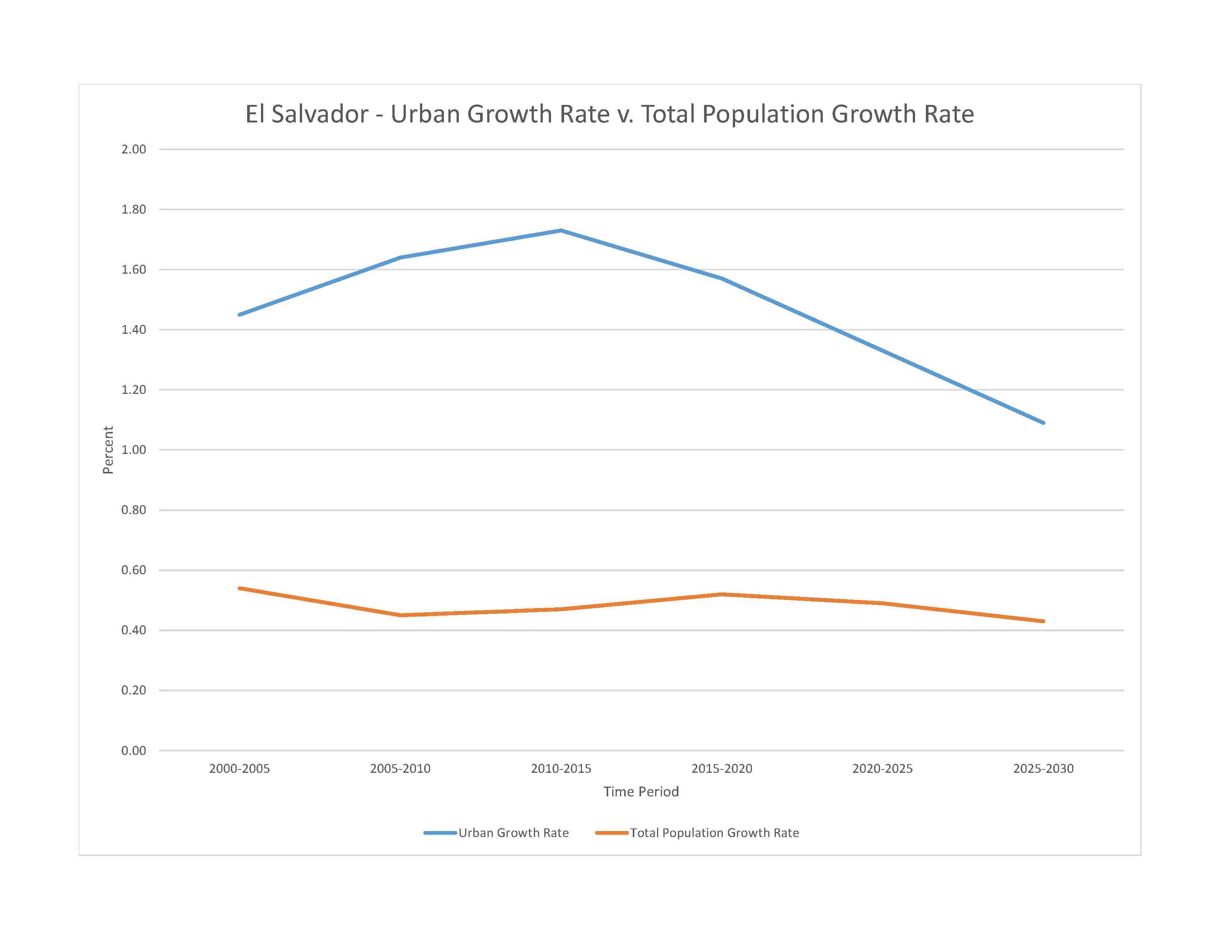
6,602,370 (2023 est.)
noun: Salvadoran(s)
adjective: Salvadoran
Mestizo 86.3%, White 12.7%, Indigenous 0.2% (includes Lenca, Kakawira, Nahua-Pipil), Black 0.1%, other 0.6% (2007 est.)
Spanish (official), Nawat (among some Indigenous)
major-language sample(s):
La Libreta Informativa del Mundo, la fuente indispensable de información básica. (Spanish)
The World Factbook, the indispensable source for basic information.
Spanish audio sample:
Roman Catholic 50%, Protestant 36%, other 2%, none 12% (2014 est.)
El Salvador is the smallest and most densely populated country in Central America. It is well into its demographic transition, experiencing slower population growth, a decline in its number of youths, and the gradual aging of its population. The increased use of family planning has substantially lowered El Salvador's fertility rate, from approximately 6 children per woman in the 1970s to replacement level today. A 2008 national family planning survey showed that female sterilization remained the most common contraception method in El Salvador - its sterilization rate is among the highest in Latin America and the Caribbean - but that the use of injectable contraceptives is growing. Fertility differences between rich and poor and urban and rural women are narrowing.
Salvadorans fled during the 1979 to 1992 civil war mainly to the United States but also to Canada and to neighboring Mexico, Guatemala, Honduras, Nicaragua, and Costa Rica. Emigration to the United States increased again in the 1990s and 2000s as a result of deteriorating economic conditions, natural disasters (Hurricane Mitch in 1998 and earthquakes in 2001), and family reunification. At least 20% of El Salvador's population lives abroad. The remittances they send home account for close to 20% of GDP, are the second largest source of external income after exports, and have helped reduce poverty.
0-14 years: 25.4% (male 857,304/female 819,670)
15-64 years: 66.39% (male 2,072,784/female 2,310,573)
65 years and over: 8.21% (2023 est.) (male 232,684/female 309,355)
total dependency ratio: 51.3
youth dependency ratio: 39
elderly dependency ratio: 12.3
potential support ratio: 8.1 (2021 est.)
total: 29.2 years (2023 est.)
male: 27.7 years
female: 30.7 years
0.46% (2023 est.)
17.5 births/1,000 population (2023 est.)
5.9 deaths/1,000 population (2023 est.)
-7 migrant(s)/1,000 population (2023 est.)
athough it is the smallest country in land area in Central America, El Salvador has a population that is 18 times larger than Belize; at least 20% of the population lives abroad; high population density country-wide, with particular concentration around the capital of San Salvador
urban population: 75.4% of total population (2023)
rate of urbanization: 1.33% annual rate of change (2020-25 est.)

1.116 million SAN SALVADOR (capital) (2023)
at birth: 1.05 male(s)/female
0-14 years: 1.05 male(s)/female
15-64 years: 0.9 male(s)/female
65 years and over: 0.75 male(s)/female
total population: 0.92 male(s)/female (2023 est.)
20.8 years (2008 est.)
note: data represents median age at first birth among women 25-29
43 deaths/100,000 live births (2020 est.)
total: 11.9 deaths/1,000 live births (2023 est.)
male: 13.6 deaths/1,000 live births
female: 10.2 deaths/1,000 live births
total population: 75.6 years (2023 est.)
male: 72.2 years
female: 79.3 years
2.04 children born/woman (2023 est.)
0.99 (2023 est.)
71.9% (2014)
improved: urban: 99.6% of population
rural: 94.2% of population
total: 98.2% of population
unimproved: urban: 0.4% of population
rural: 5.8% of population
total: 1.8% of population (2020 est.)
9.9% of GDP (2020)
2.87 physicians/1,000 population (2018)
1.2 beds/1,000 population (2017)
improved: urban: 100% of population
rural: 97.1% of population
total: 99.2% of population
unimproved: urban: 0% of population
rural: 2.9% of population
total: 0.8% of population (2020 est.)
degree of risk: high (2023)
food or waterborne diseases: bacterial and protozoal diarrhea
vectorborne diseases: dengue fever
24.6% (2016)
total: 2.94 liters of pure alcohol (2019 est.)
beer: 1.5 liters of pure alcohol (2019 est.)
wine: 0.06 liters of pure alcohol (2019 est.)
spirits: 1.37 liters of pure alcohol (2019 est.)
other alcohols: 0 liters of pure alcohol (2019 est.)
total: 7.9% (2020 est.)
male: 14.1% (2020 est.)
female: 1.7% (2020 est.)
5% (2014)
55% (2023 est.)
women married by age 15: 4.3%
women married by age 18: 19.7% (2021 est.)
4.1% of GDP (2020 est.)
definition: age 15 and over can read and write
total population: 89.1%
male: 91.3%
female: 87.3% (2019)
total: 12 years
male: 12 years
female: 12 years (2018)
NOTE: The information regarding El Salvador on this page is re-published from the 2024 World Fact Book of the United States Central Intelligence Agency and other sources. No claims are made regarding the accuracy of El Salvador 2024 information contained here. All suggestions for corrections of any errors about El Salvador 2024 should be addressed to the CIA or the source cited on each page.
This page was last modified 04 May 24, Copyright © 2024 ITA all rights reserved.